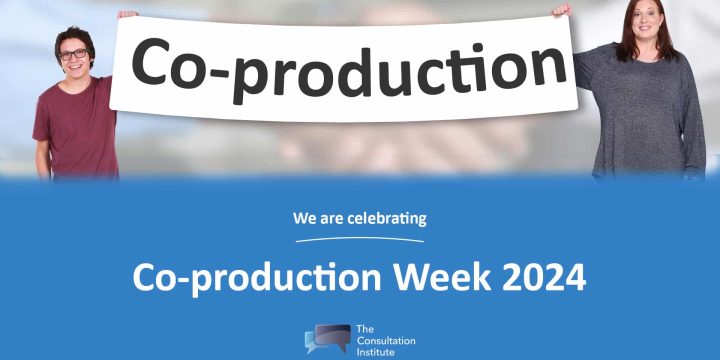News & Insights
Examining Co-production Part 2: The Right Preparation
In Part 1 I explored the right circumstances for co-production. In this article I explore the right preparation. In future articles I will cover:
- The right relationships
- The right support
- Bringing about behaviour change
- Measuring and evaluating
- Implementing
Principles
Nesta set out six principles that should run throughout the coproduction process:

Nesta set out learning questions to critically reflect on and assess the depth of co-production in each of the principles, providing a useful framework to understand the components of co-production and how to self-assess where your organisation or service is starting from.
Codesign
The sources I have reviewed tended to talk just as much about co-design, in particular the Experience Based Co-Design (EBCD) model developed by the Point of Care Foundation, and so it has been helpful to include these findings in my research.
The Point of Care Foundation state that sites who have used a co-design approach have found that it is:
• A natural way to progress the relationships that have already emerged between patients and staff
• A way to actually lessen the workload on staff; with patients and carers taking on many of the improvement actions themselves
• A way to keep up the momentum of change – where patients are part of the change team, they bring enthusiasm, drive, energy and a level of expectation.
• A way to keep up the momentum of change – where patients are part of the change team, they bring enthusiasm, drive, energy and a level of expectation.
The right preparation
In part 1 I explored the right circumstances needed before embarking on co-production. Evidence shows that having a shared definition relevant to each project or particular service, which is understood and shared by all involved, is key to the success and value of co-production. Reflecting what I described in part 1, research indicates that any definition of the term should ensure it includes aspects similar to the following
- People who use services being involved as equals with professionals.
- Co-production being the approach from the beginning of a project.
- People who use services having power to be respected, have the ability to make changes and have an impact.[1]
The latest work from the Social Care Institute for Excellence states that:
‘Co-production is about developing an equal relationship between people who draw on services and the people responsible for services. Where there is good co-production of care and support, people work together, from design to delivery, sharing strategic decision-making about policies as well as decisions about the best way to deliver support.’[2]
Harris and Boyle state that what holds co-production projects together, is that they are all ways in which patients, pupils, parents or service users are being asked to do something, to give back and to help deliver the service. This generally means providing mutual support, which in turn strengthens the delivery of effective public services, but it can mean delivering other aspects of services – not those which require professional skills, but the aspects of services dependent on broader human capacities.[3]
Organisational preparation
A key requirement for co-production is that everyone involved has the authority to move outside of the normal way of doing things. A study found four key elements in the organisational culture that contributed to success:
(1) emphasis on non-hierarchical, multidisciplinary collaboration between and among healthcare professionals and patients;
(2) organisational staff demonstrate mutual recognition and respect;
(3) commitment to rapid improvement, which ensured that research was quickly translated into implementation; and
(4) the constant and iterative process of data collection and reflection facilitated by the use of quality improvement methods and the commitment to act on that learning.[1]
For health and social care organisations and services, this would require detailed conversations with leadership to create the conditions to allow culture to change. Studies indicate that the co-production model to be used should be considered early in the process, but also the importance to feasibility test the approach and refine it.[2]
It may also involve reviewing the project based approach to service improvement in health and social care, as processes need to flex and adapt and timescales become less predictable.
Having an initial model supports communicating the intentions and requirements of the co-production process to leadership.
The EBCD process encourages organisations to take a little time to better understand the experiences of those delivering or receiving care, via proactive engagement and gathering feedback. It highlights the need to develop a plan with key people and a shared understanding of the improvement aims, key milestones and timescales.[3] Another study highlighted the importance of patients and health‐care professionals jointly identifying and prioritising meaningful service improvement efforts, based on mutual understanding gained in partnership. It found that quality improvement efforts seem more successful when patients are invited to share their individual concerns, and when health‐care professionals respond to them relevantly[4]
Many studies highlighted the need to plan for appropriate resource and that everyone appreciate the substantial time and resources that are required to meaningfully co-produce a health service/intervention. Those involved need to allow time to build relationships between the stakeholder co-production group, as this can facilitate sharing of thoughts and discussion later in the process.[5] It is helpful to have a needs analysis phase to identify ground rules and shared stakeholder needs which needs to be reviewed and evaluated using co-production techniques. [6] A report on an international co-design collaboration talked about how to build credibility for the project by encouraging the organisation to see lived experience as key evidence for improvements, securing champions amongst clinicians, partnering with social care researchers, demonstrate impact as soon as possible, and take advantage of opportunities to co-produce when they arise, to build on organisational successes.[1]
This indicates it is important for any co-production process to have an exploratory phase early in the planning, to understand the appropriate model to adopt, utilise existing understanding of patients views or gather those experiences, and communicate that to leaders and stakeholders who will facilitate the culture, time and resources needed, developing organisational and clinical champions.
It also highlights a key point I see in practice, that organisations need to utilise existing opportunities for co-production. Often I see plans for co-production that are working from scratch, whilst simultaneously ending very effective engagement projects and progress made in them is lost. Organisations need to iterate, not obliterate and build on the engagement work they have already done, growing it into new areas and refining it into co-production. The method of Human Centred Design[2] works in this way, iterating projects until they meet objectives.
Consistent knowledge and aims
In a study of six EBCD projects[1], knowing about co-design and embracing lived experience knowledge was vital to success. It found that using co-design requires everyone to understand the approach and processes for service users and health professionals. The study states: ‘Ensuring there is clarity around co-design processes upfront builds shared expectation that enables people to feel a sense of accountability for change and to mobilise around this. This includes valuing and preferencing lived experiences of services as expert kinds of knowledge from the basis of which to co-develop solutions and improvements.’
There were a number of challenges across the six projects:
- People developed skills inconsistently
- Participation of staff and service users was not consistent, which led to gaps in people’s understanding
- When not confident, staff fell back on the traditional ways of doing improvement and led to reinforcement of existing divisions and power imbalances.
- The project was too heavily resourced on the experience gathering phase and so resource for implementation was lacking
- Staff changed over time and valuable knowledge and experience was lost.
These reports highlight the importance of investment in time and for consistent resource for the length of time a co-production or co-design project will take, from early engagement through to implementing and evaluating the improvements. It also highlights the importance of everyone understanding the process, the timeline of the project and the time they will need to commit.
Involving people
As a review of co-production found, ‘one of the challenges faced when preparing for and doing co-production is being able to offer individualised ways for participants to become involved. This becomes harder when co-production wants to involve more people, particularly people from a range of diverse backgrounds with a multitude of different needs and preferable ways of working’.[1]
There are a myriad of approaches to recruiting the right people into a co-production process. In a Canadian project, recruitment of the seniors and family caregivers for the project element teams was done by a peer caregiver. They were very proactive in the development of the process and scheduled face-to-face home visits with the seniors and caregivers to ensure there was a good match between the individual and the work required. The report describes that the process was time consuming, but it was worthwhile as they had 100% success in recruiting seniors and caregivers for all the co-design teams. Those who weren’t able to join a co-design team were given other opportunities to have input (e.g., through email, interviews, surveys). Patients and caregivers were offered an hourly rate to attend project meetings, some of which lasted as long as six hours. About two-thirds of the participants accepted the payment and one third did not want to be compensated.[2]
In a review of international case studies[3], all cases had challenges establishing and sustaining repeated engagement over the course of the projects. Symptoms and life circumstances interfered with some people’s ability for prolonged engagement. Projects involving youth with mental health issues noted high dropouts due to health crises, housing transitions and service closures such as foster home changes. In an Australian study of adults with mental illness, the greatest challenge was identifying carers (i.e., friends and family in a caring relationship to the person) for some adults with mental illness. Only half of the study participants reported having carers, and services were not able to provide accurate, up to date contact information for them. In the study involving domestic violence survivors, local participants were less willing to come forward and participate because “they were really scared and worried”. In the young offender study, recruitment proved impossible due to legal anonymity for young offenders prior to age 18, and a reluctance of staff members to act as gatekeepers in the research, stating they did not have the time. The report identified some other tips:
- Build on trust where it already exists
- Engage an “insider” as a champion
- Recruit through established networks, informal groups, voluntary or “outside the box” organisations, use peer to peer approaches, targeted social media
- Engage with participants in advance of research processes
- Flexibility and Responsiveness
- Have flexible participation options (in-person, video, email, online) using a variety of media for data (art-based, music, crafts, visual diaries, photographs)
- Bring codesign process to informal community spaces or online
Nesta sets out a number of case studies where co-production utilises existing and communities as in the work by Shared Lives.[1] They also set out the key components to engage communities:
• ‘Enabling mechanisms’. These support access to person- and community-centred approaches, and connect the world of formal health and care services with local communities. They include personalised care and support planning, personal budgets, social prescribing and bridging roles such as health trainers and community navigators.
• Person- and community-centred approaches. These encompass a very broad range of practice and support that complements and enhances clinical care for people with long-term conditions (such as peer support) to everyday community activities that enable people to improve their health and wellbeing (such as a local football team or gardening club).
‘While person and community-centred approaches vary significantly, they are united by a common purpose: to put people and communities at the heart of health and wellbeing, focusing on what is important to people, what skills and attributes they have and on the role of their family, friends and communities’.[2]
The Social Care Institute for Excellence, Mayday Trust and Think Local Act Personal[3] provide resources on strengths-based community engagement, ensuring services see people and communities as assets with experience and value that complement and enhances clinical skills. When understanding their starting point, organisations need to:
1. Co-design a new vision and co-produce a plan
2. Invest in simple and human support approaches
3. Use their money and power intentionally and with a strong focus on reducing inequality
4. Co-produce a shared picture of what good looks like and user-friendly ways to track its achievement
They provide a self-assessment framework for organisations for each aspect.
Conclusion
This article has explored findings on how to prepare a co-production process, looking at what makes up co-production and co-design, how organisations and services need to prepare their culture and leadership ensuring everyone has full knowledge of the process and aims of the co-production exercise. It also reviews some methods of involving people and using strength based approaches.
My findings indicate that practitioners can be overwhelmed by the range of mechanisms that can be used and the commitment of time and resources required for a successful process.
The final word goes to a useful quick self-assessment from the Social Care Institute for Excellence, Mayday Trust and Think Local Act Personal[1] that give an overview of where your organisation might be in progressing co-production:
Where is your area on co-production?
Use the table below to assess where you think your area is.
| Statements for reflection |
| Leaders set expectations that people are involved in the design, commissioning, delivery and evaluation of services. |
| We consistently involve people with lived experience and carers as equal partners in planning their care and support. |
| There are co-production arrangements such as co-production panels and forums in place to give people a voice in how strategic decisions about care and support are taken. |
| People with lived experience are involved in providing staff development and training in strengths-based approaches. |
[1] People Powered Health Co-production Catalogue Nesta April 2012
[2] EBCD: Experience-based co-design toolkit – Point of Care Foundation
[3] The Value Of Co-Production Within Health and Social Care Reviewer, author & co-editor Susan Conquer (Co-production Coordinator, Healthwatch Suffolk), Co-editor Luke Bacon (Research Officer, Healthwatch Suffolk), Peer reviewers from the University of Suffolk Dr Will Thomas (Associate Professor), Sophie Walters (Citizen Involvement Coordinator), Professor Helen Langton (Vice-Chancellor and CEO) 2021
[4] Unlocking the potential of adult social care Critical review tool to help social care leaders move towards a strengths-based, whole-place approach, Social Care Institute for Excellence June 2021
[5] THE CHALLENGE OF CO-PRODUCTION How equal partnerships between professionals and the public are crucial to improving public services David Boyle and Michael Harris December 2009
[6] Patient and Public Involvement in Healthcare Quality Improvement: How organizations can help patients and professionals to collaborate Alicia Renedo, Cicely Alice Marston, Dimitrios Spyridonidis & James Barlow 2014
[7] Multi-stakeholder perspectives on co-production: Five key recommendations following the Liverpool Co-PARS project Benjamin JR Buckley, Jacqueline Newton, Stacey Knox, Brian Noonan, Maurice Smith & Paula M Watson 2022
[8] EBCD: Experience-based co-design toolkit – Point of Care Foundation
[9] How might patient involvement in healthcare quality improvement efforts work—A realist literature review Carolina Bergerum RN, RM, MSc, Johan Thor MD, MPH, PhD, Karin Josefsson RNT, PhD, Professor, Maria Wolmesjö PhD, 2019
[10] Multi-stakeholder perspectives on co-production: Five key recommendations following the Liverpool Co-PARS project Benjamin JR Buckley, Jacqueline Newton, Stacey Knox, Brian Noonan, Maurice Smith & Paula M Watson 2022
[11] Multi-stakeholder perspectives on co-production: Five key recommendations following the Liverpool Co-PARS project Benjamin JR Buckley, Jacqueline Newton, Stacey Knox, Brian Noonan, Maurice Smith & Paula M Watson 2022
[12] Codesigning health and other public services with vulnerable and disadvantaged populations: Insights from an international collaboration, Gillian Mulvale, Sandra Moll PhD, Ashleigh Miatello, Glenn Robert, Michael Larkin, Victoria J. Palmer, Alicia Powell, Chelsea, Melissa Girling 2018
[13] The Field Guide to Human-Centered Design, IDEO.org 1st Edition 2015
[14] Anyone can co-design?”: A case study synthesis of six experience-based co-design (EBCD) projects for healthcare systems improvement in New South Wales, Australia Tara L. Dimopoulos-Bick, Claire O’Connor, Jane Montgomery, Tracey Szanto, Marion Fisher 2019
[15] The Value Of Co-Production Within Health and Social Care Reviewer, author & co-editor Susan Conquer (Co-production Coordinator, Healthwatch Suffolk), Co-editor Luke Bacon (Research Officer, Healthwatch Suffolk), Peer reviewers from the University of Suffolk Dr Will Thomas (Associate Professor), Sophie Walters (Citizen Involvement Coordinator), Professor Helen Langton (Vice-Chancellor and CEO) 2021
[16] Charting A New Path Part 2: Creating Meaningful Partnerships In Care: Lessons From West Northumberland, Ontario, The Change Foundation 2014
[17] Codesigning health and other public services with vulnerable and disadvantaged populations: Insights from an international collaboration, Gillian Mulvale, Sandra Moll PhD, Ashleigh Miatello, Glenn Robert, Michael Larkin, Victoria J. Palmer, Alicia Powell, Chelsea, Melissa Girling 2018
[18] People Powered Health Co-production Catalogue Nesta April 2012
[19] Realising the value Ten key actions to put people and communities at the heart of health and wellbeing Nesta November 2016 [1] What next for strengths-based areas? Report from the Social Care Institute for Excellence, Mayday Trust and Think Local Act Personal November 2022
[20] What next for strengths-based areas? Report from the Social Care Institute for Excellence, Mayday Trust and Think Local Act Personal November 2022
[21] What next for strengths-based areas? Report from the Social Care Institute for Excellence, Mayday Trust and Think Local Act Personal November 2022



